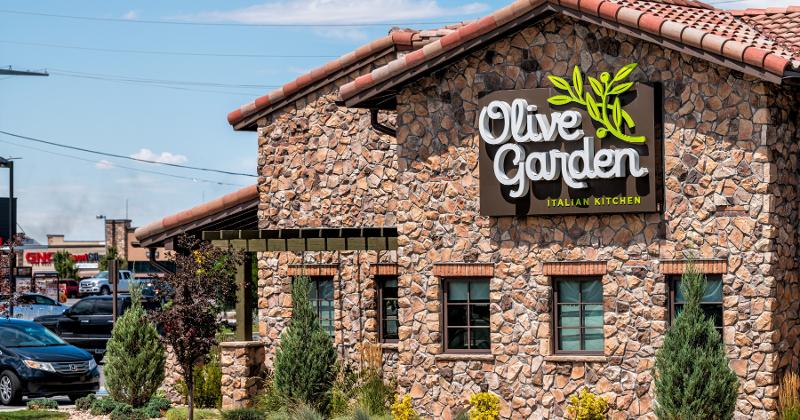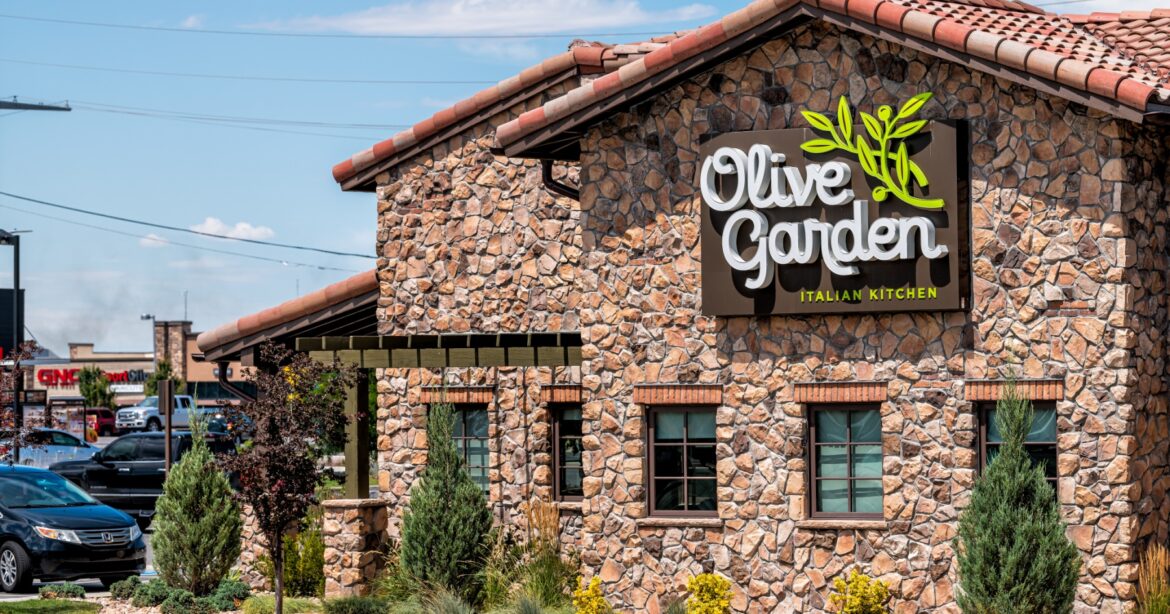
The brand has made affordability a focus. | Photo: Shutterstock
Olive Garden is testing entrees with smaller portions in an effort to offer customers more affordable options.
The new menu section features downsized versions of seven existing Olive Garden entrees at a lower price. They come with the chain’s standard helping of unlimited breadsticks and soup or salad.
Forty percent of Olive Garden’s 933 restaurants are offering them with positive results. Affordability scores at those restaurants have jumped 15%, and customers say they’re still satisfied with the serving size.
Executives for parent company Darden Restaurants said Thursday that while customers may end up spending less on average, the option will be a traffic driver in the long run. Olive Garden has not yet put any marketing behind the initiative but has already seen a slight uptick in frequency since starting the test.
“It’s not necessarily new guests, because we haven’t marketed it,” said Darden CEO Rick Cardenas during an earnings call Thursday. “It’s just, people are gravitating toward that.”
Olive Garden is one of several restaurant chains experimenting with smaller, lower-priced dishes as consumers continue to watch their spending. Its regular, large helpings are still there, but it wants to give customers more options.
“It adds price breadth to the menu, so consumers can choose,” Cardenas said.
Smaller portions are part of an ongoing focus on affordability at Olive Garden, which has kept price increases lower than inflation and has leaned into value with rotating offerings like the Never-Ending Pasta Bowl, which returned last month.
The strategy has translated into two straight periods of robust same-store sales growth at the chain. Same-store sales rose 5.9% in the quarter ended Aug. 24, Darden said Thursday, exceeding its expectations.
In the quarter, Olive Garden was promoting a create-your-own-pasta platform highlighted by a spicy three-meat sauce and bucatini pasta for $12.99. It also launched a premium Calabrian steak and shrimp bucatini that quickly became a customer favorite, climbing into Olive Garden’s top 10 most-ordered entrees.
Delivery also continues to be a sales and traffic driver for Olive Garden. In the quarter, it began promoting the service in earnest by offering 1 million free deliveries. Volume doubled during the campaign and remained 40% higher afterwards. Delivery accounted for 5% of Olive Garden’s overall sales in the period.
The chain said delivery customers tend to be younger and more affluent, with higher check sizes. They are also not likely to be on-premise customers. About 50% of delivery orders are incremental, Cardenas said.
Darden-owned Cheddar’s Scratch Kitchen is now also offering delivery and seeing good results, and a third Darden brand will be launching it soon.
Olive Garden’s investments in delivery and affordability did come at a slight cost. Restaurant-level profit margins fell 10 basis points year over year, to 20.6%.
“We believe long-term, these are the right decisions we’re making,” said CFO Raj Vennam when asked about the profit dip. “I think any business would envy a 20-plus segment profit margin.”
The strong top-line performance was another sign of the resurgence of casual dining. Olive Garden competitors such as Chili’s, BJ’s Restaurants and Applebee’s also reported sales and traffic growth over the summer, even as fast-food and fast-casual chains struggled.
Cardenas attributed the success to lower relative pricing in casual dining compared to other segments, as well as the experience and atmosphere full-service restaurants offer. And he believes consumers are becoming even more focused on price and value.
“Guests are going toward price certainty, so they know what they’re going to pay before they come in, or greater perceived value, even if the item is a high price,” he said.
Darden’s other concepts, excluding fine dining, also posted strong quarters. Same-store sales at LongHorn Steakhouse rose 5.5%, and same-store sales in the “other business” group rose 3.3%, led by Cheddar’s.
Same-store sales in fine dining declined 0.2%.
On the bottom line, Darden is contending with a double-digit increase in beef prices driven by lower supply, a screwworm outbreak in Mexico and tariffs on Brazil. Executives said they don’t believe the prices are sustainable, and Darden is holding off on locking in beef purchases for the next six months until they stabilize.
“Part of the reason we don’t believe that kind of price increase is sustainable is because the consumer can’t afford these,” Vennam said. “Over time there should be some demand destruction.”
Despite the overall solid performance, Darden stock slumped more than 9% on Thursday after its earnings per share came in at $1.97, slightly below Wall Street consensus of $2.
Members help make our journalism possible. Become a Restaurant Business member today and unlock exclusive benefits, including unlimited access to all of our content. Sign up here.


Comments are closed.